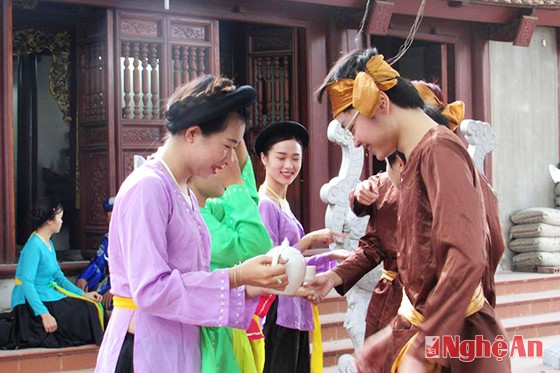(VOVworld) - Vietnamese Vi-Giam folk singing was officially recognized by UNESCO as an intangible cultural heritage of humanity at the 9th session of its Inter-governmental Committee for the Safeguarding of the Intangible Cultural Heritage in Paris on November 27. Recent changes in Vi-giam singing, ranging from performance to means of expression mean that local efforts to preserve it are intended to make it easier to access and be revived in the community.

The Vietnamese delegation is happy to welcome the announcement of the President of the UNESCO’s Inter-governmental Committee for the Safeguarding of the Intangible Cultural Heritage to officially recognize Vietnam’s Vi-giam folk singing. (Photo: Bich Ha/Vietnam+)
|
Vi-giam singing is a type of traditional folk music practiced in the central provinces of Nghe An and Ha Tinh. It is popular in nearly 260 villages in these provinces where 51 singing clubs with over 800 vocalists actively operate to preserve the genre.
Vi-Giam folk music, estimated to have 15 tunes of Vi and 8 airs of Giam, is a form of music sung while working. It reflects the work, cultural lives and feelings of central coastal residents. This style of singing, without musical accompaniment, plays an important role in the cultural life of the people and it has been preserved from generation to generation.

Members of a club in preservation of Nghệ region’s folk singing heritage, part of he the Vietnam Union of UNESCO Associations, are performing in Xuan La communal house in Hanoi. (Photo: Thanh Phong)
|
But the means of performance of the art form and the ways of expression are the two biggest changes. In addition to becoming more broad-minded and with contemporary with ancient lyrics, many Vi-giam songs have been set with new words, variants aimed to help them.
“Since I was small, I was interested in folk singing. Whenever I joined a village’s art performance, I always chose folk songs to sing. I don’t remember how old I was at that time. Now I’m studying at a teachers’ training school and want to become a teacher. But my passion for Vi-giam will accompany me forever.”
That is what Nguyen Thi Nga, a member of the folk-singing club of Ngoc Son commune in Nghe An, told us. Coming to Nghe An and Ha Tinh today, it’s not strange at all to find many young people and teenagers learning to sing Vi-giam, regular activities by folk-singing clubs, and young people involved in Vi-giam singing festivals.
During Vietnam’s difficult years, farmers sung Vi-giam while working in the rice fields or fishing in the rivers to express their sentiments. Now, although the means of production have changed to modern equipment that has also modified the art’s performance space, the singing has never for that reason fallen into oblivion.
 |
| A performance to reproduce the central region’s cultural space known as Hong Lam; it’s conducted right by Hanoi’s West Lake (Photo: Thanh Phong) |
Instead Vi-giam songs are performed at festivals and competitions or sometimes simply recorded as a gift for those who live far from home. Artisan Tran Khanh Cam from Ha Tinh has collected and preserved dozens of ancient Vi-giam tunes. He said: “Vietnamese people now still like folk songs. Although there are many modern songs, old people don’t like them. They often ask me to make compact discs comprised of folk songs for them. Nghe Tinh people who have to move to the southern region to work or to go to Taiwan or Angola always love songs about the homeland and the native folk-songs.”
Nguyen Ngoc At, Director of the Center for Conservation and Promotion of Nghe Folk Heritage, said Vi and Giam folk songs have been continually handed down and enriched through generations.
He noted that the longer the Nghe dialect lives, the longer the art form will exist, adding: “Vi-giam songs are the symbol of the Nghe regions dialect. To help it live forever, the most important thing is to pass it on to as many generations as possible and spread it among the community, strictly coordinated with local people and administrations at various levels to preserve and promote the art form.”
A number of cultural experts agree that the flexibility of Vi-giam singing has brought it closer to today’s life and its vitality has become stronger than ever in the cultural and spiritual life of many Vietnamese people, particularly those in the central region.
Uniquely in Nghe An and Ha Tinh, almost all the people can sing at least a couple of Vi-giam tunes. Folk singing clubs have been set up in villages. Since 1998 the number of such clubs has increased to 77, not to mention school clubs and the many who sing Vi-giam songs at public art performances or use it to express their feelings or thoughts during daily activities.
According to Professor Nguyen Chi Ben, former Director-General of the Vietnamese Cultural Institute, “the vitality of Vi Dam folk songs is reflected in their popularity, from lullabies for babies to fishing chants. These folk songs are often sung with the accents of the Nghe An and Ha Tinh regions. I think the values of Vi-Dam satisfy all of UNESCO’s criteria.”
But Meritorious artist Pham Tien Dung, Deputy Director of Nghe An’s Department of Culture, Sports, and Tourism, said there remain worries about the real situation of folk singing in the community because performing guilds declined in parallel with the fall of the traditional craft guilds. That is the main reason why some experts say the restoration and conservation of Nghe folk singing faces difficulties.
Despite these obstacles, a number of other researchers, including music researcher Dang Hoanh Loan, have a strong belief in the vitality of Vi-giam singing.
Loan said through the lyrics of Vi-giam songs, we can imagine the hardships of Vietnam during the resistance wars against French colonialists and American imperialists. Loan noted: “people in the Nghe region have protected the art form by recalling the time when the traditional craft guilds still existed, and bringing it to public art performances, festivals, and professional stages in theaters. Generally Vi-giam has long been linked to the Nghe people who have updated its style and concerns to match contemporary social life.”
In recent years Nghe An and Ha Tinh provinces have cooperated in organizing programs to spread Vi-giam singing among communities by strengthening the operation of clubs at the grassroots level.
Meritorious artist Pham Tien Dung said: “We are restoring the performance of Vi-giam folk songs and ancient melodies by improving the network of clubs in wards and communes. The singing and performances should be organized in line with the conditions, environment, and pattern of the performance. How ancient melodies were created will also be articulated and revived on stage.”
It’s not an exaggeration to say that the strength of Vi-giam is that it is a time-honored custom of the people of Nghe An and Ha Tinh, and contributes to enriching the local culture.
Let’s enjoy a Giam tune named ‘Inviting a quid of betel and areca’ performed by Meritorious artist Hong Luu.